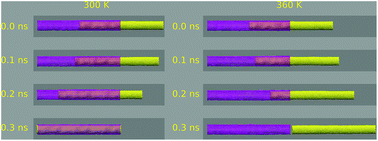An intrinsic energy conversion mechanism via telescopic extension and retraction of concentric carbon nanotubes†
Abstract
The conversion of other forms of energy into mechanical work through the geometrical extension and retraction of nanomaterials has a wide variety of potential applications, including for mimicking biomotors. Here, using molecular dynamics simulations, we demonstrate that there exists an intrinsic energy conversion mechanism between thermal energy and mechanical work in the telescopic motions of double-walled carbon nanotubes (DWCNTs). A DWCNT can inherently convert heat into mechanical work in its telescopic extension process, while convert mechanical energy into heat in its telescopic retraction process. These two processes are nearly thermodynamically reversible. The underlying mechanism for this energy conversion is that the configurational entropy changes with the telescopic overlapping length of concentric individual tubes. We also find that the entropy effect enlarges with the decreasing intertube space of DWCNTs. As a result, the spontaneous telescopic motion of a condensed DWCNT can be switched to extrusion by increasing the system temperature above a critical value. These findings are important for fundamentally understanding the mechanical behavior of concentric nanotubes, and may have general implications in the application of DWCNTs as linear motors in nanodevices.



 Please wait while we load your content...
Please wait while we load your content...